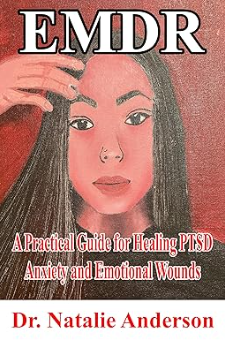 About EMDR A Practical Guide for Healing PTSD, Anxiety, and Emotional Wounds:
About EMDR A Practical Guide for Healing PTSD, Anxiety, and Emotional Wounds:
EMDR: A Practical Guide for Healing PTSD, Anxiety, and Emotional Wounds
By Dr. Natalie Anderson, PhD
Are you struggling with the weight of past trauma, persistent anxiety, or emotional wounds? Unlock the transformative power of Eye Movement Desensitization and Reprocessing (EMDR), a groundbreaking therapy that has changed the lives of millions worldwide.
In EMDR: A Practical Guide for Healing PTSD, Anxiety, and Emotional Wounds, Dr. Natalie Anderson provides a comprehensive yet accessible roadmap for understanding and leveraging the healing potential of EMDR therapy. Whether you’re a therapist seeking to expand your toolkit, a trauma survivor exploring options for healing, or someone eager to manage everyday stress and anxiety, this book is your ultimate guide to lasting emotional wellness.
What You’ll Discover:
The Science Behind EMDR: Gain a deep understanding of how EMDR works to reprocess trauma and emotional pain.
Step-by-Step Guidance: Learn the phases of EMDR therapy and how to prepare for your healing journey.
Practical Self-Help Techniques: Explore actionable EMDR-inspired exercises to use in daily life.
Tailored Approaches for Diverse Needs: Discover specialized applications for children, teens, relationships, and culturally sensitive contexts.
Integration with Other Therapies: Maximize your results by combining EMDR with complementary therapeutic approaches.
Real-Life Stories: Be inspired by success stories from individuals who have reclaimed their lives with EMDR.
Who Should Read This Book?
This book is perfect for anyone seeking to:
Heal from trauma, PTSD, or anxiety.
Strengthen emotional resilience and enhance relationships.
Understand EMDR from both personal and professional perspectives.
Why Choose This Book?
Written by Dr. Natalie Anderson, a leading expert in trauma recovery, this practical guide is rooted in science, enriched with real-world insights, and tailored to empower readers at every stage of their healing journey.
Take the first step toward reclaiming your peace and living a life free from the burdens of past pain. With EMDR: A Practical Guide for Healing PTSD, Anxiety, and Emotional Wounds, hope and healing are within your reach.
Order your copy today and embark on your transformative journey!
Buy the book:
Author Bio:
Dr. Natalie Anderson is a renowned psychologist and trauma therapist with over 15 years of experience in the field of mental health. Holding a doctorate in Clinical Psychology from Stanford University, she specializes in trauma recovery and the application of innovative therapeutic techniques such as E M D R (Eye Movement Desensitization and Reprocessing). Throughout her career, Dr. Anderson has worked with a diverse range of clients, including individuals suffering from P T S D, anxiety, depression, and childhood trauma.
Her passion for healing trauma stems from her personal experience as a survivor of a traumatic event in her early adulthood. This journey sparked a deep interest in therapeutic modalities that could foster long-term recovery and emotional well-being. After being introduced to E M D R therapy during her doctoral studies, Dr. Anderson became a certified E M D R therapist and later a trainer, guiding other professionals in mastering this powerful technique.
Dr. Anderson is also the author of several scholarly articles on trauma and recovery and has been featured in numerous publications, including Psychology Today and The Journal of Trauma and Recovery. In addition to her clinical work, she conducts workshops and seminars on trauma healing, E M D R therapy, and mindfulness practices, helping individuals and mental health professionals alike.
With a warm, empathetic approach, Dr. Anderson is committed to empowering others through self-help tools, providing a holistic view of trauma recovery. In her free time, she enjoys hiking, practicing yoga, and spending time with her family.
Dr. Anderson’s goal in writing this book is to make E M D R therapy accessible to anyone seeking to heal emotional wounds, regardless of whether they are receiving formal therapy or practicing techniques on their own.